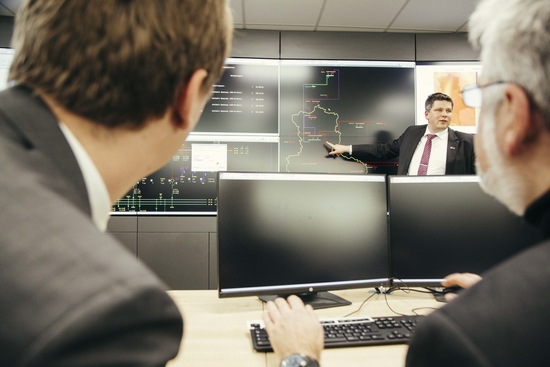Opening of the control room
Modern network control system for monitoring and controlling European energy networks goes into operation at the University of Magdeburg
At the Otto von Guericke University Magdeburg, one of the most modern control rooms for monitoring and controlling the entire European energy network was put into operation. The control center, which is equipped with a 5 x 1.5 meter projection screen, was set up in a laboratory of the Faculty of Electrical Engineering and Information Technology and enables a precise replication of the real European energy network. It can detect and localize faults and accidents within seconds, as well as control demands and different feed-in of regenerative energies.
A special feature of the control room is an interface to the simulation software Matlab, with which the control room can be remotely controlled. Thus, interventions in a disturbed or optimized energy supply can be prompt and precise. In the future, the large unit will be used for the development and testing of network and system management concepts as well as the practical training of students of the university.
Background Information
Transmission grids that supply entire countries with electrical energy are centrally coordinated from several points in network control rooms. These control the flow of electricity in normal operation, but must also detect faults immediately and take appropriate countermeasures. Due to the growing feed-in of large amounts of wind and solar energy by many small producers, the processes in the network are becoming much more complex and dynamic and their control increasingly complex.
According to Prof. Martin Wolter of the Institute for Electrical Energy Systems of the University of Magdeburg, wind energy is mainly generated in northern Germany and fed into the grid, but the large urban areas with high power consumption are often in the south. So electric energy must be transported over long distances. "In Saxony-Anhalt we have an overproduction of wind feed, and the trend is rising. Wind exports also overlap with transboundary European energy flows. As a result, there are increasing bottlenecks in the network that can only be remedied by costly feed-in management, "says the network expert. "The increasing smallness and dynamics in the network is hardly manageable by shift personnel. That's why we're developing and testing effective and optimized network control systems, which will ultimately lead to a cost reduction for the electricity customer in the country. "
The network control center at the University of Magdeburg was co-financed by the state of Saxony-Anhalt and the German Research Foundation (DFG).









